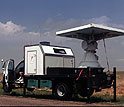News Release 05-091
Rapid-Scanning Doppler on Wheels Keeps Pace with Twisters
Updated instrument promises a better look at how tornadoes form

Doppler on Wheels has caught dozens of tornadoes in action.
June 1, 2005
This material is available primarily for archival purposes. Telephone numbers or other contact information may be out of date; please see current contact information at media contacts.
A new Doppler radar instrument that can scan tornadoes every five to 10 seconds is prowling the Great Plains this spring in search of its first close-up twister. Newly enhanced for season-long thunderstorm tracking, the radar promises the most complete picture to date of tornado evolution, allowing for better tornado prediction in the future.
Known as the Rapid-Scan Doppler on Wheels (DOW), the instrument was deployed from a temporary base in Hays, Kan., by scientist Joshua Wurman of the Center for Severe Weather Research. Engineers at the National Center for Atmospheric Research (NCAR) in Boulder, Colo., helped build the DOW, which is funded by the National Science Foundation (NSF).
Most Doppler radars transmit only a single beam, which takes about five minutes to make the vertical and horizontal scans needed for a three-dimensional storm portrait. But tornadoes can develop or dissipate in a minute or less. With its five- to 10-second resolution, the Rapid-Scan DOW can detail these critical steps in tornado behavior at close range.
"The development of the multi-beam mobile Doppler radar is an important advance in meteorological research," says Steve Nelson, director of NSF's physical and dynamic meteorology program, which funded the research. "This new radar will collect higher resolution data than were possible in the past, giving us unique measurements of rapidly evolving meteorological phenomena like tornadoes."
The first DOW was deployed in 1995. Since then, Wurman and his colleagues have collected data on more than 100 tornadoes. On May 3, 1999, a DOW measured a world-record wind speed of 301 miles per hour just above ground level in an Okla. tornado.
As part of a $1.6 million NSF grant, Wurman and Curtis Alexander of the University of Oklahoma are analyzing the entire DOW data set on tornadoes to uncover new information, such as how closely tornado diameters are correlated with top wind speeds.
"We can't answer basic questions about 'typical' tornadoes right now, such as how strong their winds are," says Wurman. "By looking at these cases, we hope to better understand the features of many types of tornadoes." These findings could be compared to storm types to produce improved warnings, Wurman adds.
Wurman and NCAR scientists plan to select a few tornadoes for more in-depth study. They'll use a technique called velocity track display (VTD), originally developed for hurricane studies, that allows scientists to extract three-dimensional wind information from a single Doppler radar.
The scientists have already used VTD with DOW data to analyze a large and intense tornado that struck Mulhall, Okla., in 1999. They discovered a central downdraft, similar to the eye of a hurricane, surrounded by a ring of updrafts blowing at near-hurricane force, with multiple small vortices rotating around this ring. The structure found in the Mulhall tornado had been observed for many years in lab experiments and computer models, but it had never before been verified by radar data.
Dubbed ROTATE-05, this spring's field work is supported by the National Geographic Society.
-NSF-
-
Deployment of the new Rapid-Scan Doppler on Wheels.
Credit and Larger Version
Media Contacts
Cheryl Dybas, NSF, (703) 292-7734, email: cdybas@nsf.gov
Anatta , NCAR, (303) 497-8604, email: anatta@ucar.edu
The U.S. National Science Foundation propels the nation forward by advancing fundamental research in all fields of science and engineering. NSF supports research and people by providing facilities, instruments and funding to support their ingenuity and sustain the U.S. as a global leader in research and innovation. With a fiscal year 2023 budget of $9.5 billion, NSF funds reach all 50 states through grants to nearly 2,000 colleges, universities and institutions. Each year, NSF receives more than 40,000 competitive proposals and makes about 11,000 new awards. Those awards include support for cooperative research with industry, Arctic and Antarctic research and operations, and U.S. participation in international scientific efforts.
Connect with us online
NSF website: nsf.gov
NSF News: nsf.gov/news
For News Media: nsf.gov/news/newsroom
Statistics: nsf.gov/statistics/
Awards database: nsf.gov/awardsearch/
Follow us on social
Twitter: twitter.com/NSF
Facebook: facebook.com/US.NSF
Instagram: instagram.com/nsfgov



